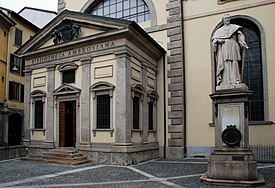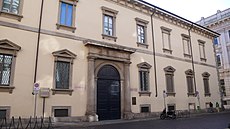Biblioteca Ambrosiana
| Biblioteca Ambrosiana | |
|---|---|
|
Biblioteca Ambrosiana
|
|
| founding | 1602 |
| Duration | approx. 1,000,000 media units |
| place | Milan |
| ISIL | IT-MI0133 |
| Website | www.ambrosiana.it |
The Biblioteca Ambrosiana is a famous Milanese library . The library was named after the church father, Ambrosius of Milan . The library is one of the most important in Europe for medieval writings and documents such as drawings, graphics and documents.
history
The Archbishop of Milan Cardinal Federico Borromeo had the new library set up in Milan since 1602. On December 8, 1609, the Biblioteca Ambrosiana was opened to the public. The cardinal thus connected a college of 16 scholars, who were supposed to make the relevant works known for their respective subjects and to advise the visitors. Lack of money limited the College of Doctores bibliothecae Ambrosianae to a few members.
Over the next decade, the library, along with the Pinacoteca Ambrosiana art gallery opened in 1618 and the Art Academy opened in 1621, became a scientific and cultural center of Italy. Soon after the library was founded, various private collections were added, including those of Gian Vincenzo Pinelli , Francesco Ciceri (1521–1596) and Cesare Rovida .
Establishing a library was an unusual step for a cardinal and caused a stir. According to the understanding of the time, such foundations were more a wealthy secular prince than an archbishop. Federico Borromeo struggled with difficulties for decades in getting this project through. Neither in Rome nor in Milan was he unconditionally supported in securing his project financially.
The library was badly damaged in the bombing of Milan by US troops in 1943. The reconstruction took place under the direction of Luigi Caccia Dominioni .
Duration
Borromeo already put together an extensive collection of codices, including Greek and Oriental manuscripts, for whose acquisition he sent buyers to Greece and the Orient. At the end of the 19th century, the library already had around 160,000 printed works and 8,000 manuscripts.
The library's current holdings include over 850,000 prints, 35,000 manuscripts and over 2,100 incunabula , 10,000 drawings, 30,000 engravings, as well as a coin collection and an archaeological collection.
The most important pieces in the collection include:
- 51 fragments with 58 miniatures of the Ilias Ambrosiana from the 5th century
- 1119 pages of the Codex Atlanticus by Leonardo da Vinci , a gift from Galeazzo Arconati from 1637
- a manuscript of De divina proportione by the mathematician Luca Pacioli with drawings by Leonardo da Vinci
- The Kitab al-Hayawan (Book of Animals) by al-Jahiz
- Autographs by Ariost , Boccaccio , Galileo Galilei , Alessandro Manzoni , Giuseppe Parini , Petrarca , Alessandro Manzoni and the Milanese poet and social critic Carlo Porta.
Librarians
Throughout its history, the library has had a number of eminent scholars as library directors. They include:
- the historian Giuseppe Ripamonti (1573-1643), whose detailed description of the plague in Milan of the 16th century source of Alessandro Manzoni's novel The Betrothed was
- the historian Ludovico Antonio Muratori , who is considered the father of Italian historiography
- Cardinal Angelo Mai , who in 1819 rediscovered and edited an extensive, hitherto unknown text from Cicero's De re publica as a palimpsest in the Vatican library
- Achille Ratti, who later became Pius XI. Became Pope
- Biblical scholar and Hebraist Gianfranco Ravasi , currently President of the Pontifical Commissions for Sacred Archeology and for the Cultural Assets of the Church
Federico Galli has been the head of the library since 2008.
literature
- Pamela M. Jones: Federico Borromeo and the Ambrosiana. Art patronage and reform in seventeenth-century Milan. Cambridge University Press, Cambridge 1993, ISBN 0-521-42051-2 .
- Chiara Continisio, Maria Luisa Frosio, Elena Riva. (Ed.): La biblioteca delle meraviglie. 400 anni di Ambrosiana. De Agostini, Novara 2010, ISBN 978-88-511-1508-1 .
- Marie Lezowski: L'abrégé du monde. Une histoire sociale de la bibliothèque Ambrosienne (v. 1590–1660) (= Bibliothèque d'histoire de la Renaissance . Volume 9 ). Classiques Garnier, Paris 2015, ISBN 978-2-8124-5076-1 (French).
See also
Web links
- Website of the Biblioteca Ambrosiana (Italian, English)
- Catalogus codicum graecorum Bibliothecae Ambrosianae (Mediolani 1906) Tomus I
- Catalogus codicum graecorum Bibliothecae Ambrosianae (Mediolani 1906) Tomus II
- Biblioteca Ambrosiana on the ETHorama platform
Individual evidence
- ↑ La Storia della Biblioteca Ambrosiana . ( Page no longer available , search in web archives ) Info: The link was automatically marked as defective. Please check the link according to the instructions and then remove this notice. Panorama.it, October 27, 2000; Retrieved December 8, 2008
- ↑ Kitab al-Hayawan , accessed June 9, 2020
- ↑ don Federico Gallo , Università Cattolica des Sacro Cuore, Milano, accessed on June 9, 2020
Coordinates: 45 ° 27 '49.6 " N , 9 ° 11' 9.2" E


